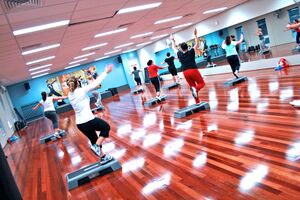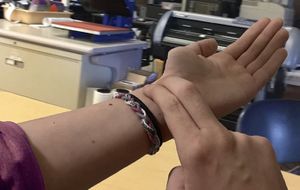Harvard Step Test
Original Editor - Sonal Joshi Top Contributors - Sonal Joshi, Lucinda hampton and Kim Jackson
Introduction[edit | edit source]
The Harvard Step Test is used to measure a clients aerobic fitness, being a predictive test of their VO2max. It tests the cardiovascular system and reflects the general capacity of body to cope with increased physical work load and ability to recover from it[1].
This test is simple to conduct and requires minimal equipment. Participants step at a rate of 30 steps per minute for 5 minutes or until exhaustion. There are many other variations of step tests too.[2]
Intended Population[edit | edit source]
It was developed to be originally used by military personnel for fitness testing, but later used by civilian individuals also[3]. The step test can be performed in children[4], adolescents[5], adults[6]and athletes[7]. See below re modified test and uses.
Equipment[edit | edit source]
Equipment required: step or platform (Male 20 Inches /50.8 cm, Female : 16 Inches / 40 cm), stopwatch, metronome or cadence tape.
Pre-test[edit | edit source]
- Explaining the test procedure & signing consent form
- Recording anthropometric data
- Individual should be resting/sitting down for 3-5 min
- Resting Heart Rate is measured
Test Protocol[edit | edit source]
The client steps up onto, and back down from the step at a rate of 30 completed steps per minute (one second up, one second down) for 5 minutes or until exhaustion. Exhaustion is defined as when the client cannot maintain the stepping rate for 15 continuous seconds.
The client immediately sits down on completion of the test, and the total number of their heart beats are counted from 1 to 1½ minutes after finishing and from 2 to 2½ minutes after finishing and finally from 3 to 3½ minutes after finishing.
The clients heart beats are counted through feeling the clients pulse at their wrist[8].
Fitness Index Scoring[edit | edit source]
Scoring: the clients fitness index score is then determined by the following equations.
Fitness Index = (100 x test duration in seconds) divided by (2 x sum of heart beats in the recovery periods).
eg if the total test time was 300 seconds (if the client completed the whole 5 minutes), and their number of heart beats between 1-1½ minutes was 90, between 2-2½ it was 80 and between 3-3½ it was 70, then the fitness index score would be: (100 x 300) / (240 x 2) = 62.5. [8]
| Rating | Fitness Index |
|---|---|
| > 96 | Excellent |
| 83-96 | Good |
| 68-82 | Average |
| 54-67 | Low Average |
| < 54 | Poor |
Modified Versions[edit | edit source]
The Harvard Step Test is one tool for fitness assessment. Since the initial development of the Harvard Step Test for evaluation of military recruits in World War II, the basic technique has been evaluated with different modifications and successfully applied across different settings . eg:
- Modified Harvard Step Test[5] is a modification of the original Harvard step test, to make it easier to implement in all age groups. The height of the step/platform in equipment has been changed to 30 cm, rest of the protocol remains the same.
- The YMCA has developed age and gender-adjusted standards for fitness rating using one minute pulse recovery standard for a 12-inch-3-minute-96 steps/minute format
- A modified Harvard Step Test for fitness evaluation in cancer survivors. Using a step test height of 9 inches, and options of self-pacing at a slower pace and/or stopping the test prior to three minutes.[9]
- The Tecumseh step test is a modified version of the Harvard Step Test. The main differences from the original protocol were the lower step height (8 inches instead of 20), the more moderate stepping rate (24 steps/min instead of 30) and the shorter duration (3 minutes instead of 5 minutes). These alterations made this test easier to perform and suitable for epidemiological studies[10].
Viewing[edit | edit source]
This 4 and 3/4 minute video gives a summary of the Harvard Step Test protocol:
Validity & Reliability[edit | edit source]
- Valid to predict VO2 max & showed reliability on test-retest in study done on college students[12].
- Reliability is acceptable at ICC = 0.6 in a study done in adolescents[13].
Reference[edit | edit source]
- ↑ Brouha L. The step test: A simple method of measuring physical fitness for muscular work in young men. Research Quarterly. American Association for Health, Physical Education and Recreation. 1943 Mar 1;14(1):31-7.
- ↑ Top end sports Harvard Step Test Available:https://www.topendsports.com/testing/tests/step-harvard.htm (accessede 8.4.2022)
- ↑ https://en.wikipedia.org/wiki/Lucien_Brouha
- ↑ Sandstedt E, Fasth A, Eek MN, Beckung E. Muscle strength, physical fitness and well-being in children and adolescents with juvenile idiopathic arthritis and the effect of an exercise programme: a randomized controlled trial. Pediatric Rheumatology. 2013 Dec;11(1):1-1.
- ↑ 5.0 5.1 Toumpakari Z, Jago R, Howe LD, Majid HA, Papadaki A, Mohammadi S, Jalaludin MY, Dahlui M, Nahar Azmi Mohamed M, Su TT, Johnson L. Cardiometabolic risk factors and physical activity patterns maximizing fitness and minimizing fatness variation in Malaysian adolescents: a novel application of reduced rank regression. International journal of environmental research and public health. 2019 Jan;16(23):4662.
- ↑ Marshall AR, Rimmer JE, Shah N, Bye K, Kipps C, Woods DR, O’Hara J, Boos CJ, Barlow M. Marching to the Beet: The effect of dietary nitrate supplementation on high altitude exercise performance and adaptation during a military trekking expedition. Nitric Oxide. 2021 May 27.
- ↑ Quinto G, Neunhaeuserer D, Gasperetti A, Battista F, Foccardi G, Baioccato V, Gobbo S, Bergamin M, Ermolao A. Can exercise test intensity and modality affect the prevalence of arrhythmic events in young athletes?. Research in Sports Medicine. 2021 Jun 5:1-9.
- ↑ 8.0 8.1 PT direct Harvard Step Test Available:https://www.ptdirect.com/training-delivery/client-assessment/harvard-step-test-a-predictive-test-of-vo2max (accessed 8.4.2022)
- ↑ White KR, Lu J, Ibrahim Z, Furth PA. Modified Harvard Step Testing within a Clinic Setting Enables Exercise Prescription for Cancer Survivors. medRxiv. 2020 Jan 1.Available:https://www.medrxiv.org/content/10.1101/2020.09.30.20204776v1.full (accessed 8.4.2022)
- ↑ Wiki Tecumseh step test Available:https://en.wikipedia.org/wiki/Tecumseh_step_test#cite_note-1 (accessed 8.4.2022)
- ↑ Stacie. Harvard Step Test. Available from: https://youtu.be/mekPTS_LVv4 [last accessed 28/11/2021]
- ↑ Soliman Ismail W. Evaluating the validity and reliability of Harvard step test to predict VO2max in terms of the step height according to the knee joint angle. Journal of Applied Sports Science. 2011 Jul 1;1(2):126-32.
- ↑ Domaradzki J, Cichy I, Rokita A, Popowczak M. Effects of tabata training during physical education classes on body composition, aerobic capacity, and anaerobic performance of under-, normal-and overweight adolescents. International Journal of Environmental Research and Public Health. 2020 Jan;17(3):876








